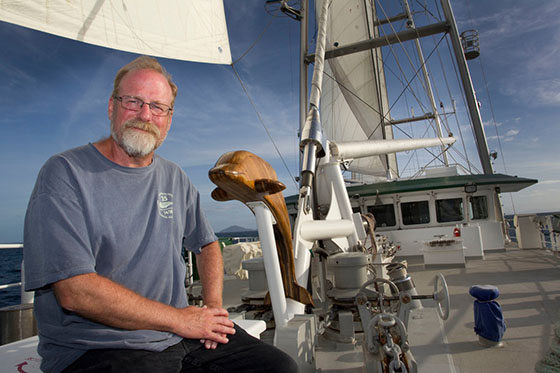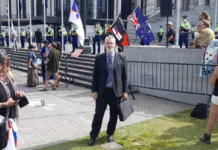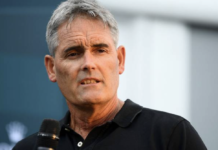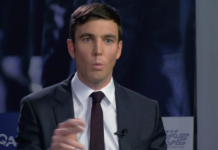

A personal tribute to STEVE SAWYER by former Rainbow Warrior captain PETER WILLCOX, who was skipper at the time of the Rongelap evacuation and the French bombing in 1985.
David Robie also blogs at Café Pacific
.
I MET Steve in 1981 in New Bedford, Massachusetts, on the first Rainbow Warrior. I was answering a job advert he had placed in the National Fisherman. We spoke in his cabin for a while, and then went to the mess to meet the crew.
One of the things Steve liked about the manager’s job on the RW was that he got to do real physical work as well as intellectual organising. The crew was all giving him a hard time about his painting technique. It seems the day before, Steve, while climbing down into an inflatable (not a rhib by a long shot), had stepped directly into a five-gallon bucket of paint.
That he took the ribbing good-naturedly and laughed with everyone else was to me an excellent sign of life on board that ship.
Steve was the first guy I ever worked for who was younger than I. I was 28, and he 25 in 1981. But I learned fast not to mess with him. He could argue you into a corner quickly, and he did not suffer fools.
A few months later, we were up in Maine, replacing the motor and generators with new diesels. And Steve was right in the thick of it. One time he was underneath the new 16-cylinder GM diesel, I think drilling a hole in the steel engine bed to run a fuel line. I can safely say that it was not an OSHA approved work site.
Steve was sitting on a 2 x 12 plank over a ton or so of diesel and motor oil, the engine room bilge. He was drilling with a 120-volt drill, and it was tough work. Then the drill stopped. He looked by down the electric cord, and saw that he had pulled the plug and socket into the oil. He quickly pulled it out and it burst into flame. He dropped it back in the diesel, and squirmed his way out from under the engine with rather a serious expression on his face.
First big campaign
Steve studied philosophy in college, and was a near All American baseball pitcher. I will explain the significance of this in a minute.
The first big campaign we did was a Canadian seal campaign. I mentioned Steve had studied philosophy in college. The campaigner, a Canadian whose name I will not mention (but his initials are P.M.), threw the I Ching many times during the campaign, mostly as a way to get me back to the bridge to push further and further into the ice. The first RW had no kind of ice class, or any kind of class for that matter. The year before with a fancy ice pilot on board, they had bent the propeller.
Every time the Canadian would throw the I Ching he would claim it said, “Go forward”. This would drive Steve crazy. I could see him cringing. And I know he never forgave the Canadian campaigner.
I’m sure Steve was the one who convinced the organisation to put sails on the first Warrior. I am not sure how he did it. But we built the masts, got the sails, cut the bridge wings off, made a bowsprit, did a lot of work in the engine room all for around $US120,000. This was in the days when we did 90 percent of the work ourselves, before we would just pull into a ship yard and tell them to get busy.
The next campaign we did was also organised by Steve. It was the evacuation and resettlement of the people from Rongelap. Our mission that year, 1985, was to protest against nuclear testing in the Pacific. The first part of the trip was in the Marshall Islands, and Steve went out there in 1984 to see what we could do.
“Give us a ride”, he was told. And that’s how we moved 350 people 120 miles across the ocean with everything but their church and livestock. I am sure that many of my shipmates would agree that it was probably the most significant thing any of us ever did. I certainly feel that way. Thanks to Steve.
Fastball folly
It was during this campaign that I received a batch of Sports Illustrated magazines from home. I got into an article about a young baseball pitcher for the Mets named Sidd Finch, who could throw a fastball at a ridiculously high speed. After finishing the article, I ran down to the mess to show it to Steve.
Steve got about a quarter of the way through it, closed it, looked at the date, chuckled, and threw it back to me.
“Total bullshit” was all he said.
Steve immediately knew that no one could throw a baseball at 168 mph. He also caught that the article was written by George Plimpton, a founder of the Paris Review and a literary critic, not a sport journalist. The other clue was the date on the cover: April 1st, 1985. But that was Steve. Way smarter than the average bear.
It was a year or two before then that Steve met Kelly. They became, I think, the best couple I have ever met, outside of Pete and Toshi Seeger. Both terrifically hard working and dedicated, to the environment and their family.
Steve went on to become an ED of both GpUSA and International, and I saw him less and less. When I think about it now, he had an absolutely huge impact on my life.
Thank you, very very much, Steve.
- Republished with permission from Pete’s Facebook page.
- Read tributes about Steve and his shipmates at David Robie’s microblog Eyes of Fire : Thirty Years On





Steve Sawyer sounds like an absolute unsung hero!
We need more Steve Sawyer’s!
We also need to re examine modern living where it is now illegal to do so many activities in case things go wrong “I can safely say that it was not an OSHA approved work site” and discouraged from doing new things unless you go through a massive process, with paperwork, lawyers, insurance, etc. Simple protests now seem to be a minefield and protest itself seems to be being made harder to do.
Kids are not even allowed to walk to school in some peoples eyes. The more likely risks and advantages and practicality (aka obesity & traffic gridlock) are overlooked in our officials punitive way of looking at modern life, where rules govern ordinary peoples’ lives and how they bring up children, in a way that was never there a generation ago.
Not sure kids are any safer now than they were 50 years ago in fact they seem to be more likely to commit suicide and suffer mental illness with all the dangers that are pointed out to them on a daily basis instead of focusing on everyday life and self development.
Martyn has a point where he equates many millennials extreme levels of identity politics, extreme individualism and inability to compromise on what they think is the right way to think/talk/be with the bubble like political environment they are bought up in.
The first man into space Yuri Gagarin used to walk to school in the snow in bare feet.
It is hard to reconcile pushing forward into the unknown with how our laws are stopping modern kids growing up and people trying new things and being able to live differently.
As more and more people’s lives are mostly inside, the environment will suffer, as less people actually know about the environment or use it in everyday lives.
Environment becomes more a commercial entity rather than everyone’s right.
Comments are closed.